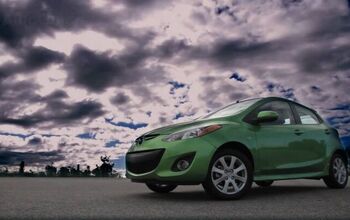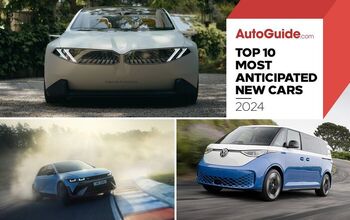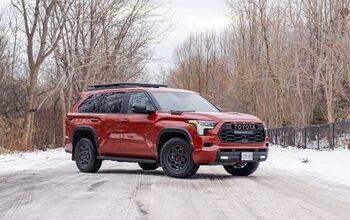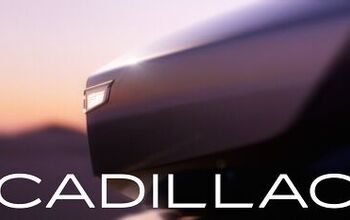2010 Honda Fit Review
The trip from Havana to Paris might not be as exotic as you’d expect when it takes place entirely in Arkansas, but this narrow pass that connects the two southern state towns is providing plenty of thrills. Challenging both driver and car, it tests the surprisingly sporty road manners of the Fit Sport, Honda’s itsy-bitsy five-door hatchback outfitted with a fuel-stingy engine.
FAST FACTS
| 1. The 117-hp 1.5L gets 27/33-mpg (city/hwy) for the manual or Sport automatic and 28/35-mpg for the automatic in base trim. |
| 2. Cargo room is a spacious 20.6 cubic feet or a total of 57.3 cu.-ft. with the rear seats folded. |
| 3. Six airbags are standard with stability control standard on Sport models. |
| 4. The Fit Sport includes upgrades such as a body kit and spoiler, 16-inch wheels, fog lights, a chrome exhaust pipe, cruise control, a 160-watt sound system, remote entry and paddle shifters for the automatic transmission. |
SIZED TO FIT
With a roof barely five feet high and the pint-size body about 13 feet long, the little Fit resembles a sleek bullet dominated by a quick-sloped windshield and hood capped by a body-colored grille separating vast headlamp clusters mounted on the front corners.
Sport models like our test car add ground effects with a front fascia housing a broad air intake port and foglamps. Also included in the top-trim Sport model are alloy wheels and a roofline spoiler extending over the tail.
DESIGNED TO BE DRIVEN
Sold as the Jazz overseas, this platform is offered in 70 different markets throughout the world. The genius of the setup is the utility it allows with a compact suspension design that carves out more space for the passenger compartment and a lower floor for easy entry.
Honda installs independent MacPherson struts in front with a stabilizer bar and an H-shaped torsion beam with stabilizer bar in the rear. The steering system gets electric power assistance, which eliminates a load of hydraulic equipment and contributes to the efficiency of Fit’s modest engine.
Stopping power comes from a front disc, rear drum setup with standard ABS with electronic brake force distribution (EBD). Added safety features come with the top trim Fit Sport thanks to stability assist (VSA) with a traction control system (TCS). Also in the safety department are six standard airbags.
SURPRISING POWER
Under the hood a single-cam 1.5-liter 4-cylinder is made from aluminum with a drive-by-wire throttle and Honda’s i-VTEC (variable value timing and lift electronic control) technology to precisely manage engine breathing and combustion in order to maximize horsepower and disperse torque across a broad band. It produces 117-hp at 6000 rpm plus torque of 106 ft-lbs at 4800 rpm.
Two five-speed transmissions are offered (auto and manual) with the latter an engaging experience, while the electronically controlled automatic boosts fuel economy and even comes with steering wheel-mounted paddle shifters on the Sport model.
The car’s compact dimensions and 2,489-pound curb weight factor in to its high fuel economy scores with the EPA giving it a 27/33-mpg (city/highway) rating for the manual and a 28/35-mpg rating for the automatic. Sport automatic models do, however, rate the same as the manual.
SPACIOUS WHERE IT COUNTS
Climb inside to discover that the cabin feels airy and roomy, despite overall dimensions that tie the Fit to the smallest category of cars. The cockpit floor dips low so you can step aboard easily, and the ceiling bows high up front to fit tall chair-like seats on the front row. Passengers in the two front buckets sit upright, with their heads positioned high for better visibility though the ring of windows.
Designers counterbalanced spatial confinements of a small car by raising the roof and lengthening the wheelbase to fashion a cabin that seems spacious even for backseat passengers and also provides 20.6 cubic of cargo room (or an incredible 57.3 cubic feet with rear seatbacks down).
A clean and efficient layout for the cockpit sets the instrument panel below an arched bonnet, with a sporty three-spoke steering wheel (with audio and cruise control commands on Sport models). HVAC controls are also located immediately to the right of the driver making for excellent ease of use.
In the rear there’s a 60/40 split bench that Honda calls the "Magic Seat" as the seatbacks dive down and bottom sections flip up to vary configurations for passengers and cargo. The rear seatbacks can fold away to form a virtually flat cargo floor or the front seats will recline flush with rear seat bottoms to make a long and flat cushioned area like a bed.
THE VERDICT
The entry edition 2010 Fit with a five-speed manual transmission lists for $14,900, or $15,700 with the automatic shifter. Sport models start at $16,410 (manual) or $17,260 (automatic) and you can toss in Navigation (a rarity in this segment) for a total of $18,260 (manual) and $19,110 (automatic).
While it’s certainly not the $10,000 econo box that some automakers are offering in this segment, with the Fit you get what you pay for and then some. It has plenty of standard equipment, great options, tons of style (inside and out), is fun to drive and great on fuel. In its segment, the Fit is so good it’s almost not fair.
RELATED READING
2011 Ford Fiesta: First Drive
2009 Toyota Yaris
2009 Hyundai Accent GLS 4-Door
2009 Hyundai Accent SE 3-Door Hatchback
2009 Chevrolet Aveo5 LT Review
2009 Nissan Versa Hatchback
LOVE IT
- Excellent fuel economy
- Styled for the 21st Century
- Easy to park and fun to drive
LEAVE IT
- Hatchback styling not for everyone
- Somewhat buzzy 4-cylinder
- Small center console
More by Bob Plunkett



































Comments
Join the conversation